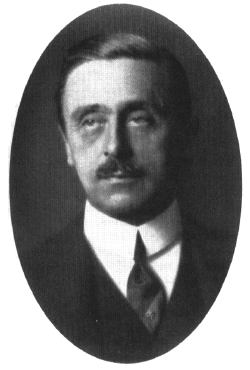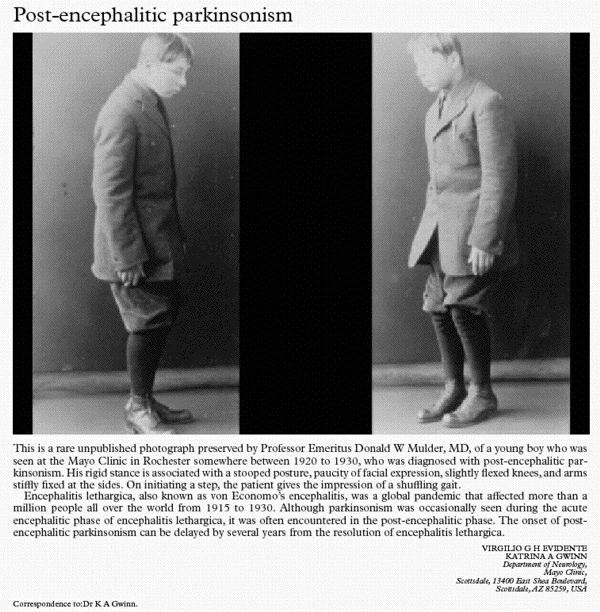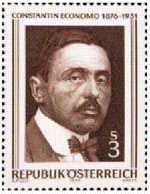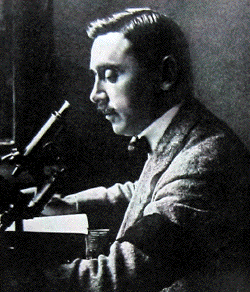- Entre 1917 et 1925, toute l'Europe est
atteinte par l'épidémie de cette
encéphalite léthargique
qu'identifia alors C.Von
Economo (1876-1931). Elle était
liée à des destructions neuronales
apparaissant aujourd'hui d'origine autoimmune,
le virus de la grippe n'étant plus
considéré actuellement comme
facteur inducteur. Les lésions
sous-corticales et
mésodiencéphaliques
déterminaient des troubles aigus, souvent
mortels, mais aussi, chez ceux qui en
réchappaient, toute une série de
perturbations chroniques, telles que des
altérations graves de l'humeur, des
manifestations dépressives ou
délirantes, des
mouvements anormaux (comme dans les
observations rapportées ici :
bâillements) à type de crises
occulogyres, de parkinsonisme etc...
L'unité du processus morbide et la
relative constance du siège des
lésions contrastaient avec le
polymorphisme des manifestations cliniques, de
telle sorte que certains en venaient alors
à mettre en doute la
réalité effective.
-
- Les découvertes contemporaines
confirment le bien-fondé des
hypothèses formulées par Von
Economo.
L'atteinte auto-immune (cf article de 2003
ci-dessous) des ganglions de la base et de
l'hypothalamus entrainait, entre autres, la
raréfaction des
neurones à hypocrétine, et
donc tarissait, de façon transitoire ou
mortelle, la sécrétion d'un des
neuromédiateurs responsables de
l'éveil. D'autres structures pouvaient
aussi être lésées, inhibant
les sécrétions de
mélatonine et expliquant ainsi les
inversions de rythme nycthéméral,
mimant le syndrome
génétique de
Smith-Magenis..
(Inversion
of the circadian melatonin rhythm in
Smith-Magenis syndrome De Leersnyder H et
al.Rev Neurol 2003; 159; 11
Suppl; 21-6)
-
- En 2004
Encephalitis
lethargica syndrome: 20 new cases and evidence
of basal ganglia autoimmunity
-
Constantin von Economo was known for bis
achievements in microscopic anatomy of the brain
as well as for bis description of an infectious
disease encephalitis epidemica lethargica, which
is characterized by increasing listlessness or
weakness, apathy, and drowsiness, passing into
coma. This disease was observed in various parts
of the world between 1915 and 1926.
-
- Economo was born in Trieste of a patricien
famlly of Greek origin. His preliminary
education was acquired in German schools in
Trieste, and bis medical training was in Vienna,
where he received bis MD degree in 1901. During
his career, he worked with the Nobel Prize
winner Julius Wagner von Jauregg, the
physiologist Siegmund Exner, and the
histologists Victor von Ebner and Josef
Schaffer. Economo was also influenced by Alois
Alzheimer and Emil Kraepelin.
- In the Wiener klinische Wochenschrift of May
10, 1917, Economo reported his clinical
investigation of a new infectious epidemic
disease. Near the end of 1917, he described it
as an encephalitis disseminated in small areas
throughout the nervous system but showing a
predilection for the gray matter of the
mesencephalon. The reaction of the nervous
system was described as nonhemorrhagic and
nonnecrotic, but inflammatory. A few months
later, its infectious character was established
by experimental transmission of the disease to
monkeys, with production of similar pathologic
characteristics. These findings were confirmed
by other investigators, and the disorder bas
become known familiarly as Economo's
disease.
-
- The disease first appeared in Romania in
1915 and raged globally until 1927.Encephalitis
lethargica was once a major cause of
post-encephalitic Parkinson's Disease, but there
have been no new cases for years. The last
reported case was in 1940, though the clinical
sequelae were seen for years after that. Economo
was a man of independent means. He rejected the
chair of psychiatry when von Jauregg retired in
1928. (LF. Haas)
-
- A second remarkable contribution was The
Cytoarchitecture of the Cerebral Cortex in Adult
Man, published in 1925. This represented an
exhaustive investigation of the cellular
structure of the brain, which Economo had begun
in 1912. A volume of 810 pages contained the
description and discussion, and a companion
volume comprised 112 plates showing typical
photomicrographs in large scale.
-
- Besides bis work in medicine and neurology,
Economo was a pioneer in aeronautics, being one
of the first civil pilots and the first military
pilot in the Austro-Hungarian empire.
-
- The iliness of which Economo eventually died
appeared first et the age of 45 years, when he
suffered a coronary occlusion. After a slow
recovery, he eventually returned to his work. He
later suffered coronary embolism, the results of
which were subsiding when cerebral thrombosis
developed, and he died at his home in Vienna on
Oct 21, 1931, at the age of 65 years. Economo
was honored in 1976 by an Austrian stamp (Scott
No. 1040) issued on the centenary of his
birth.
- Robert A. Kyle and Marc A. Shampo
JAMA 1978; 240; 6;
568
-
-
-
-
 -
- von
Economo Encephalitis; Morris S. Dickman; Arch
Neurol. 2001; 58; 1696-1698
- Télécharger
ce texte au format pdf
-
- Abstract : In April 1917, Dr
Constantin von Economo presented his clinical
and pathologic findings of a new disease-soon to
be part of a worldwide epidemic-before the
Vienna Psychiatric Society. He named it
encephalitis lethargica. After years of careful
observation, he collected and analyzed thousands
of cases and classified them into 3 clinical
syndromes: somnolentophthalmoplegic,
hyperkinetic, and amyostatic-akinetic forms. He
described the now legendary post-encephalitic
Parkinsonism, noting that symptoms could emerge
years after the original infection, often
without signs of prodromal "flu." He emphasized
the neuropathologic findings: inflammatory
changes in the tegmentum of the midbrain
accounting for the sleep disturbance and ocular
signs. After encountering sporadic cases
following the epidemic, he concluded that the
somnolentophthalmoplegic syndrome was the
primary expression of encephalitis lethargica.
This article out lines the observations and
conclusions of Dr von Economo during and affer
the epidemic through seminal quotations
primarily from his published works, as well as
from more recent reports.
-
- Early observations
- The first case of this strange new disease
appeared at the end of 1916. Under the careful
observation of Dr von Economo, a well-defined
syndrome complex began to emerge, characterized
by disturbances of sleep and ocular motility as
well as ptosis, which he described in his early
monograph.
- «It seems strange
when sleep appears as a symptom of an illness.
"Sleeping sickness" where the phenomenon of
people falling asleep while eating or working
was first described in two cases in our clinic
in Vienna in 1916. Usually headache, nausea, and
fever were followed, often the next day, by
sleeping, frequently in a most uncomfortable
position. One can wake them, but in severe
cases, coma can rapidly lead to death.
Malfunction of eye muscles, especially
oculomotor dysfunction, and ptosis, was
common.»
- In fact, of the 13 reported cases, von
Economo described 4 with ptosis, 2 with abducens
palsies, and 1 each with supranuclear palsy and
medial longitudinal fasciculus syndrome. Only 3
of the 13 had no ocular signs.
-
- Historical background
- von Economo may have known of accounts of
similar cases -and epidemics-that were reported
centuries ago, such as mendossa in Lisbon in
1521, pestilence soporeuse in Italy in 1561, and
lethargy with ocular palsies in Germany in 1605.
He was aware of an epidemic in Italy in the late
1800s, which may have given impetus to his major
life's work.
- «... a
half-forgotten memory of childhood came to the
fore. In 1890-1891 there occurred in connection
with the then pandemic influenza in Italy a
peculiar illness associated with stupor called
Nona. von Economo reported that he described his
own peculiar cases of stupor to his mother and
asked whether she remembered the accounts of the
mysterious Nona. She replied that she did»
-
- Neuropathology
- Within months of the appearance of the first
case, von Economo already had autopsy proven
evidence of the neuropathology: notably
widespread microscopic inflammatory foci,
particularly in the gray substance of the
tegmenturn of the mid brain. This was presented
before the Psychiatric Society in Vienna on
April 17, 1917, and named encephalitis
lethargica.
- «We must assume that
it is from the grey matter of this region that
the natural sleep function is influenced. This
assumption gains all the more probability
because Wernicke's encephalitis, in the wake of
delirium tremens, eye muscle disturbances and
somnolence appear, and hemorrhages are to be
found in these same parts of the
tegmentum.»
-
- Clinical presentation
- Usually associated with the influenza
epidemic that claimed more than 30 million
lives, tens of thousands of cases of
encephalitis were reported during and after the
first World War. von Economo was the first to
recognize and classify 3 distinct clinical
forms.
- «Every epidemic of
encephalitis lethargica is characterized by the
predominance of a certain combination of
symptoms.... We are able to distinguish three
forms of pathological syndromes which embrace
the great majority of cases.... These three
syndromes under which encephalitis lethargica
has appeared most frequently hitherto are the
somnolent-ophthalmoplegic, the hyperkinetic, and
the amyostatic-akinetic (the so-called
Parkinsonism ).»
-
- Somnolent-Ophthalmoplegic «The
prodromal phenomena consists of general
discomfort, shivering, headache, and slight
pharyngitis. The temperature is generally only a
little raisedto slightly above 98'C.... Within
the next few days, somnolence begins to
predominate. The patients left to themselves
fall asleep in the act of sitting and standing,
and even while walking, or during meals with
food in the mouth.... if aroused, they wake up
quickly and completely, are oriented and fully
conscious ... but soon drop back to sleep. Sleep
in this form may last for weeks or even months
but frequently deepens to a state of most
intense stupor or even a comatose condition
which may terminate fatally after some days or
weeks.
- Generally, during the
first days of the illness (cranial nerve)
palsies appear. Ptosis is one of the first and
most frequent symptoms. The frequent bilateral
occurrence of ocular palsies, incomplete usually
asymmetrical, suggest that it is, in most cases,
a nuclear palsy. Rarely observed are
supranuclear paralyses, paresis of convergence,
nystagmus, optic neuritis, papilledema,
pupillary disturbances, and even Argyll
Robertson's sign.
-
- Hyperkinetic : In the
winter of 1920, there was observed a very large
group of hyperkinetic cases, first in Italy then
Austria. Chorea and hemichorea as well as
myoclonic twitches which were observed may
degenerate into wild jactations.
- On the other hand, it may
find its mental expression in a general, curions
restlessness of an anxious or hypomanic type. In
most of these cases, there is a very distinct
sleep disturbance and generally the condition is
one of troublesome sleeplessness.
-
- Amyostatic-Akinetic :Third
place in order of frequency, the
amyostatic-akinetic form, is characterized by a
rigidity, without a real palsy and without
symptoms arising from the pyramidal tract. This
form of encephalitis lethargica is particularly
common in the chronic cases, dominating the
clinical picture as Parkinsonism. I reserve the
name "Parkinsonism" though symptomatically
identical with the amyostatic-akinetic form,
rather for the chronic cases. To look at these
patients one would suppose them to be in a state
of profound secondary dementia. Emotions are
scarcely noticeable in the face, but they are
mentally intact.»
-
- Writing in 1929, toward the end of the
devastating worldwide epidemic, von Economo
concluded that the somnolent-ophthalmoplegic
form was the primary expression of encephalitis
lethargica. If it ever recurred again, be
reasoned that it would be in this form.
- «Now that the great
epidemics of encephalitis lethargica are over,
we meet with isolated sporadic acute cases every
year. It is interesting to note that these
sporadic cases of encephalitis lethargica,
occurring at a time when there is no epidemic,
are mostly of the somnolent-ophthalmoplegic
form. Therefore, it appears probable that the
somnolent-ophthalmoplegic form should bc
regarded as the basic form proper of
encephalitic lethargica.»
-
- Geographic-specific syndromes : As
the disease ravaged Europe, von Economo
recognized particular combinations of symptoms
and syndromes, in various countries and cities
especially hard-hit by the epidemic and
classified them accordingly.
-
- Prognosis : Encephalitis lethargica
was quickly recognized as a serious, lethal
discase. Aside front a very high mortality rate,
many patients were left with significant
disabilities.
- «The prognosis of
clinically welldocumented cases of encephalitis
lethargica is: 40% mortality, 14% complete
tecovery, 26% recovery with defect, but able to
work, and 20% chronic4nvalidity. Encephalitic
lethargica must in every case bc regarded as a
serious and dangerous disease.»
-
- Chronic parkinsonism : As early as
1920 von Economo bcgan observing cases that had
apparently recovered fully, only to be stricken
with parkinsonian features months, or even
years, later.
- «Parkinsonism may
develop in immediate sequence after the
amyostatic form ... as well as 4 or 5 years
after an apparenty complete recovery fron acute
encephalitic lethargica. The acute stage may
have been slight or serious; it is of no
importance in indicating the probable
development of later symptoms. Often we see
cases where such sequelae develop with no
history of a previous acute
phase.»
-
- Oculogyric crises : Without doubt,
the oculogyric crisis was the one of the
outstanding features of postencephalitic
parkinsonism, which intrigued clinicians for
decades.
- «Of particular
interest are the visual fits, described by
French authors as "crises ocuogyres" (van
Bogaert, Bing, and Schwartz, Marinesco and
Radovici), in English as "tonic eye-fits" or,
more commonly, as oculogyric crises. They
consist of tome visual convulsions, occurring in
fits and generally lasting ony a few minutes,
during which the patients as a rule look upwards
and sideways.... Frequently, the convulsive
twisting of the eyes is also accompanied by
other convulsive movements, such as contortion
of the head in the direction of vision, tonic
stretching of the neck, even of the trunk and
extremities...»
-
- Recent observations
- While reports of presumed Economo
encephalitis or postencephalitic Parkinson
disease unrelated to the 1917-1927 pandemic have
appeared in the medical literature in the past
30 years, most of them have lacked either an
adequate documentation of encephalitis
lethargica or a convincing causal relationship
between the encephalitis and subsequent
neurologic sequelae. In one series, in almost
every case, the parkinsonian symptoms and signs
first appeared 20 to 40 years after the
encephalitis.
-
- Howard and Lees, however, carefully
documented 4 cases in 1987. While failing to
identify the viral agent, they found positive
oligoclonal banding in 3, performed postmortern
examinations in 1, and formulated specific
diagnostic criteria:
- «We propose that a
number of clinical features ... as major
criteria supporting the diagnosis of
encephalitis lethargica. It should comprise an
acute or subacute encephalitic illness . . .
[with] three of the following major
criteria: (1) signs of basal ganglia
involvement, (2) oculogyric crises, (3)
ophthalmoplegia, (4) obsessive-compulsive
behavior, (5) akinetic mutism, (6) central
respiratory irregularities and (7) somnolence
and/or sleep inversion.»
-
- Duvoisin and Yahr, in 1965, published a
review of their patients with postencephalitic
parkinsonism. They sunveyed the literature for a
similar syndrome caused by known viruses and
could find no association with any known
neurotropic viral agent:
- «The rare
association of a progressive Parkinsonim
syndrome such as is understood by the term
Parkinson's Discase with any [ known]
type of viralencephalitis ... bas not be shown
to be more than coincidental.»
-
- More than 30 years later, one of the authors
again reviewed published reports and concluded
that despite the advent of modern virology, the
failure to isolate the causative agent continues
to cast a shadow of doubt on all reported
cases:
- «Presumed cases of
von Economo's disease parkinsonism have been
reported in small numbers since 1970. The
clinical and, when available, the pathological
data are fairly convincing. However lacking a
specific confirmation, the doubt will remain
concerning the authenticity of the
diagnosis.»
-
- Von Economo C. Encephalitis Lethargica. Wien
Klin Weshr. 1917; 30; 581-583
- Von Econom. C. Die Enœphalitis
lethargica Dr C. Von Economo. Leipzig und Wein,
Germany: Franz Deuticke 1918.
- Von Economo C, Wagner Jauregg V. Baron
Constantin von Economo: His Life and Work.
Burlington, Vt: Free Press Interstate Corp;
1937.
- Von Economo C. Encephalitis Lethargica, its
Sequelae and Treatment. Translated by K.O.
Newman, Oxford University Press. London,
England; 1931.
- Wenning G, Jellinger K, Litvan I.
Supranuclear gaze palsy and eyelid apraxia in
post-encephalitic parkinsonism. J Neural Transm.
1997;104:845-854.
- Howard R, Lees A. Encephalitic lethargica: a
report of four recent cases. Brain 1987; 110;
19-28
- Duvoisin R, Yahr M. Encephalitic and
parkinsonism. Arch Neurol. 1965; 12;
227-243.
- Casals J, Elizan T, Yahr M. Postencephalitic
parkinsonism-a review. J Neural Transm. 1998;
105:645-652
 -
- Encéphalite léthargique
Cruchet, Moutier, Calmettes Soc méd hop
Paris 27 avril 1917
- Fou rire
syncopal et bâillements au cours de
l'encéphalite
épidémique Sicard JA et Paraff
A Bulletins et Mémoires de la
Société médicale des
hôpitaux de Paris 1921; 45; 232
- L'encéphalite
épidémique Reys L. Maloine.
1922
- Manifestations
tardives de l'encéphalite
épidémique (observations de
bâillements n° 7,
49,
61) G
Lévy Travail de la clinique des maladies
du système nerveux Prof Pierre
Marie Vigot ed, Paris 1922
- L'encéphalite
létharique Lhermitte J 1922
- Des altérations psychiques dans la
névraxite épidémique et la
maladie de Parkinson post-encéphalitique
Thèse 28 mars 1923 D. Nestorovith
Montpellier
- Encéphalite léthargique E. May
Nouveau Traité de Médecine t4;
Masson 1925
- Respiratory
disorders in epidemic encephalitis Turner A,
Critchley M Brain; 1925; 48; 72-104
- Postencephalitic
respiratory disorders, phenomology. Jelliffe
SE 1927
- Postencephalitic
respiratory disorders case report. Jelliffe
SE 1927
- L'encéphalite
épidémique ses origines, les 64
premières observations connues R.
Cruchet Doin Ed Paris 1928
- Mouvements
involontaires de la face et de la tête,
à allure de spasmes rythmiques, survenant
chez un malade atteint d'encéphalite
léthargique Crouzon et Ducas. La
Revue Neurologique Mai 1928, n°5
- Sleep as a
problem of localisation von Economo 1930 -
pdf
- Encephalitis
lethargica, Its sequelae and treatment Von
Economo C 1931
- Encephalitis
lethargica, Its sequelae and treatment Von
Economo C 1931 (part 2)
- Les séquelles neurologiques de
l'encéphalite épidémique
Riser et Mériel Revue Oto Neuro
Ophtalmologie 1931; n°4; 297-322 et
n°5 p323-348
- Les
séquelles de l'encéphalite
épidémique G Guillain, P
Mollaret 1932
-
- M. Baron
Constantin von Economo and encephalitis
lethargica JM Pearce JNNP 1996; 60; 167
- von Economo
Encephalitis Morris S Dickman Arch Neurol
2001; 58; 1696-1698
- Influenza
RNA not detected in archival brain tissues from
acute encephalitis lethargica cases or in
postencephalitic Parkinson cases McCall S,
Henry JM, Reid AH, Taubenberger JK J Neuropathol
Exp Neurol. 2001; 60; 11; 1121-2
- Cortical
arousal induced by microinjection of orexins
into the paraventricular nucleus of the rat
Ikuko Sato-Suzuki Behavioural Brain Research
2002; 28; 169-177
- Encephalitis
lethargica: part of a spectrum of
post-streptococcal autoimmune diseases? A
Vincent (editorial) Brain 2004; 127; 1; 2 -
3
- Encephalitis
lethargica syndrome: 20 new cases and evidence
of basal ganglia autoimmunity RC Dale, AJ
Church, RA Surtees, AJ Lees, JE Adcock, B
Harding, BG Neville, G Giovannoni Brain 2004;
127; 1; 21-33
-
-
- Baron
Constantin von Economo1876 -
1931
-
Sleep as a
problem of localisation von Economo 1930 -
pdf
|





